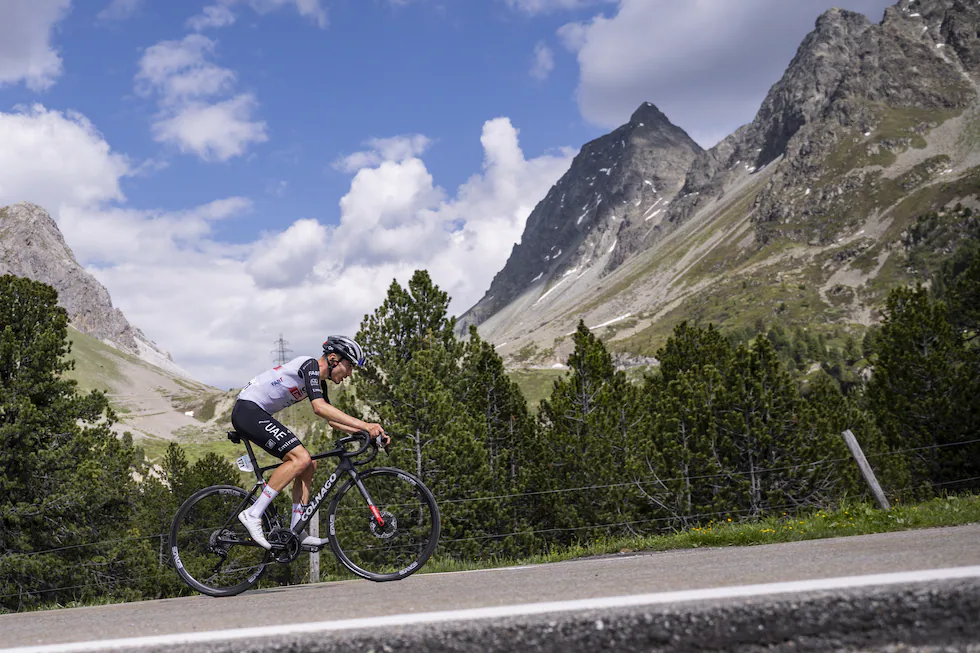
A sweet Giro d'Italia to welcome Juan Ayuso's debut
The ‘corsa rosa’, which will start from Albania on May 9, skips the Dolomites and the monster stages that forged its legend
Giro 25. Instructions. Wednesday 28 May. Stage 17. Starting from the north of Trento, finishing in Bormio, gateway to the Dolomites. 154 kilometres. Two climbs halfway through the route, the classic and easy Tonale, a second-class, and the seemingly terrifying Mortirolo, which will not be so: it is located almost 50 kilometres from the finish and is climbed via Monno, the easy side (12.6 kilometres at 7.6%), and to reach Bormio the Stelvio is sadly avoided: the riders will only pass through the crossroads of the road that ascends from the city to the giant of the Alps. A transitional stage in an epic territory. There will be no giants, climbs that touch the clouds at almost 3,000 metres, perpetual snow. No Bondone, no Gavia, no Stelvio, no Zoncolan, no Marmolada, no the Three Peaks of Lavaredo. Not even Pordoi.

Instead, an exit from Albania, a somewhat neocolonial return of Italy 80 years after having to abandon what was once occupied territory, part of the empire that Mussolini wanted to dream up in the Balkans, the times of an invented king called Zog and of the communist partisans led by Enver Hoxha who liberated the country in November 1944. The Nazi defeat in the Second World War. The Liberation of Italy on 25 April 1945, and a few weeks later the army corporal Fausto Coppi arrives in Naples after two years of captivity in Tunisia, a prisoner of the British army, and asks a newspaper for help to lend him a bicycle to start training again, he who in 1940, at the age of 20, had already won his first Giro. The past is resurrected in the form of a centre for immigrants expelled from Italy and a cycling race that loves labels.
The fight for what they like to call the most virgin DNA, the most attractive marketing label for what the fans want, leads the Grand Tours to stupidity and paradox. The Tour and the Vuelta, always traditionalists, insist on a rejuvenation cure that leads them to roughen and almost denature their routes, while the Giro, owner of the wildest scenery, the Dolomites, in the most meteorologically unpredictable month, May, seeks to soften its inevitable hardness, which leads to contradiction.
“It will be a progressively tougher route that will end in a tough but not exaggerated final week, without a monstrous stage that will dictate the verdict,” explain the organisers of a race that will start on Friday 9 May in Durrës, on the Adriatic coast, and will finish on Sunday 2 June in Rome. “This will force daily attacks, without the excuse of waiting to play everything on the toughest day.”
With 52,500 metres of total elevation gain, a thousand metres more than the Tour, the 2025 Giro, announced today, features the most apparently mountainous route in recent years – 42,900 metres in 2024 (Pogacar exhibition ); 51,300 in 2023 (Roglic); 50,948 in 2022 (Hindley); 46.900 in 2021 (Egan)—, a toughness that, examined closely, becomes almost sweet, to the delight of debutant Juan Ayuso, who will have 43 kilometres of time trial (14 + 29) in his favour, and will even be able to wear pink on the streets of Tirana on the second day, and will only be penalised with three high mountain finishes, the lowest number in recent years: a finish in the southern Apennines (Tagliacozzo, 12 kilometres at 5% on the seventh stage), one in the Trento Alps (San Valentino, 17 kilometres at 6.4%), and, perhaps the biggest day, Sestriere on the penultimate stage after climbing Le Finestre and its eight kilometres without asphalt). It will be Mikel Landa’s day, who on a similar stage slowed down in 2015 after leaving Alberto Contador, in pink, behind to protect the second place of his Astana teammate Fabio Aru. It will be, along with the previous stage, the 19th through the Aosta Valley, the only one that makes the climber from Alava dream.
There will be no stage with more than 5,000 metres of climbing, the limit between very hard and extremely hard, or lasting more than six hours. Like the Dolomites, the old trademarks of the Giro that made Coppi and Pantani legendary will fly away. There will be tourist and nostalgic stages through Tuscany, a sign of the times, a pinch of sterrato along the roads of the Strade Bianche to Siena (ninth, Sunday 18 May) and a chrono amarcord , 29 kilometres between Lucca and Pisa (tenth, 20 May), like the one in 1977 in which the Norwegian Knut Knudsen, a colossus born for the track and time trials, flew at 50 per hour, beating the untouchable Francesco Moser by a minute.
Ayuso, 22 years old and debuting in the corsa rosa, and Landa (35, eighth participation, two podiums and three stage victories) are the Spanish hope against a participation that promises to be dense, headed by Primoz Roglic, winner in 2023, and, perhaps, Jonas Vingegaard, the winner of two Tours who has never ridden the Giro.
The route of the women’s Giro was also presented at the Ennio Morricone Auditorium in Rome. It will be held in eight stages from Sunday 6 to Sunday 13 July, coinciding with the men’s Tour. The race will start in Bergamo with a 13.6km individual time trial and will finish at the Enzo and Dino Ferrari circuit in Imola, where Julian Alaphilippe won the 2020 World Championship. The queen stage, in which the best Spanish women, Eneritz Vadillo and Mavi García, will face the predictable ones – Demi Vollering, Kasia Newiadoma… – will be the penultimate stage, 3,850 metres of elevation gain on a 157km circuit through the Apennines that mark the border between Umbria and Le Marche, with the finish at the top of Monte Nerone, after a 10km climb at 8%. It was on these roads in the 2009 men’s Giro that Carlos Sastre achieved one of his toughest victories, on Monte Petrano after overcoming the Nerone and at the end of a journey lasting more than seven hours and almost 240 kilometres.
Women’s Giro route:
July 6, 1st stage, Bergamo-Bérgamo, 13.6km (CRI)
July 7, 2nd stage, Clusone-Áprica, 99km
July 8, 3rd stage, Vezza d’Oglio-Trento, 124km
July 9, 4th stage, Castello Tesino-Valdobbiadene, 156km
July 10, 5th stage, Mirano-Monselice, 108km
July 11, 6th stage, Bellaria-Orciano di Pésaro, 144km
July 12, 7th stage, Fermignano-Monte Nerone, 157km
July 13, 8th stage, Forlì-Imola, 138km







